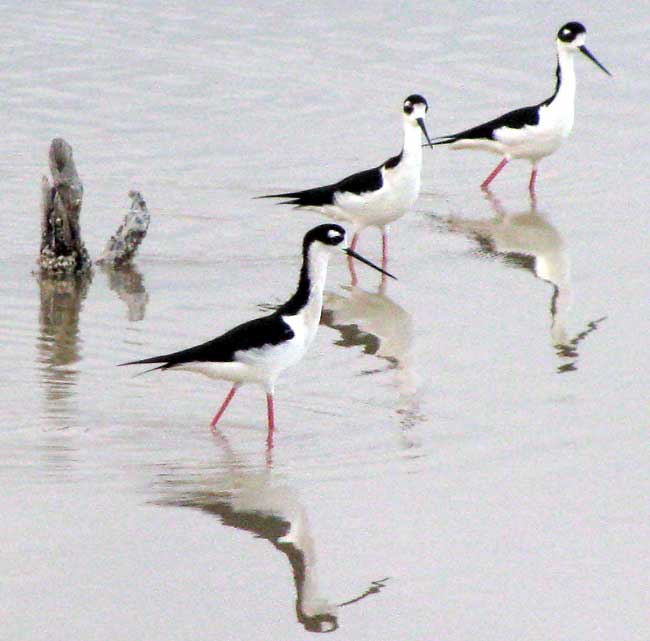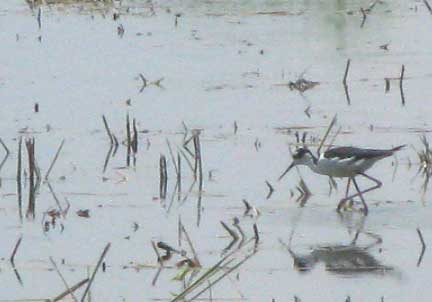Excerpts from Jim Conrad's
Naturalist Newsletter

from the January 19, 2009 Newsletter issued from San Juan Hacienda just east of Telchac Pueblo, northern Yucatán State, MÉXICO
ELEGANT BLACK-NECKED STILTS
At dawn the next morning yet another visual essay in grace greeted me at the water's edge. Three Black-necked Stilts, HIMANTOPUS MEXICANUS, advanced across mirroring shallow water so prettily I almost forgot to snap a picture, but I did take one, and you can see above.
Stilts with their neat tuxedo plumage, thin straight bill, little white eyebrows on black faces, and those surprising red legs put one in mind of organisms in coral reefs: Seeing them, you wonder why and how Nature came up with such a satisfyingly elegant design; whether a plainer design might not have sufficed for a being whose main job is to probe into the muck for worms and such, and whose call is a monotonous series of piping notes. Seeing Black-necked Stilts, you understand that Nature has an impulse for style, you don't understand why, but you're glad She does.
Field guides often show Black-necked Stilts with slightly upturned bills, but you can see that our birds' bills are straight as needles. I've observed individual stilts whose bills did bend upward a little, but straight ones are much more common.
Here Black-necked Stilts are permanent residents. In the US they occur along the Gulf Coast and much of the Pacific Coast, expanding northward during the summer, and inland through much of the US Southwest. They extend southward to southern South America.
from the August 19, 2012 Newsletter issued from the woods of the Loess Hill Region a few miles east of Natchez, Mississippi, USA
STILTS IN THE REFUGE'S PUMP-FLOODED FIELDS
Because of the drought upstream the Mississippi River is so low that in places barge traffic is impossible. Therefore I wasn't surprised this week when Karen and I visited St. Catherine Creek National Wildlife Refuge just south of Natchez and found that where during most of the year there are flooded fields and swamps, now there's dry land. However, many fields were indeed flooded, for the Refuge managers pump water into them specifically for wildlife. An article in the Natchez Democrat reports that in the Refuge about 200 acres (81has) are being flooded for birds.
Even now in August well before most migrating birds have begun arriving from the North certain water-loving species were using the flooded flats, such as the Black-necked Stilt stalking through shallow water below:

Mostly we've seen Black-necked Stilts in Mexico, but here they're summer breeders, and some might overwinter here in mild winters. The species appears to be expanding its area of distribution. One wonders how birds like stilts are surviving this summer's extreme drought, which is occurring mostly in the Black-necked Stilt's breeding grounds in the western and south-central US. This year for many species the Refuge's artificially-flooded fields are truly refuges.